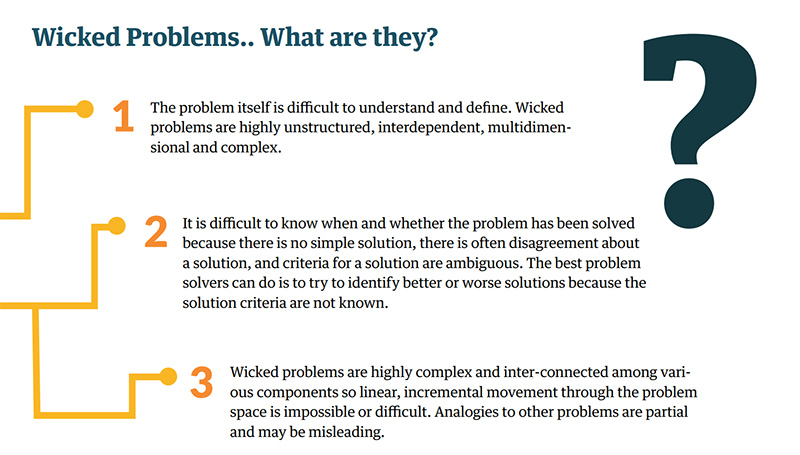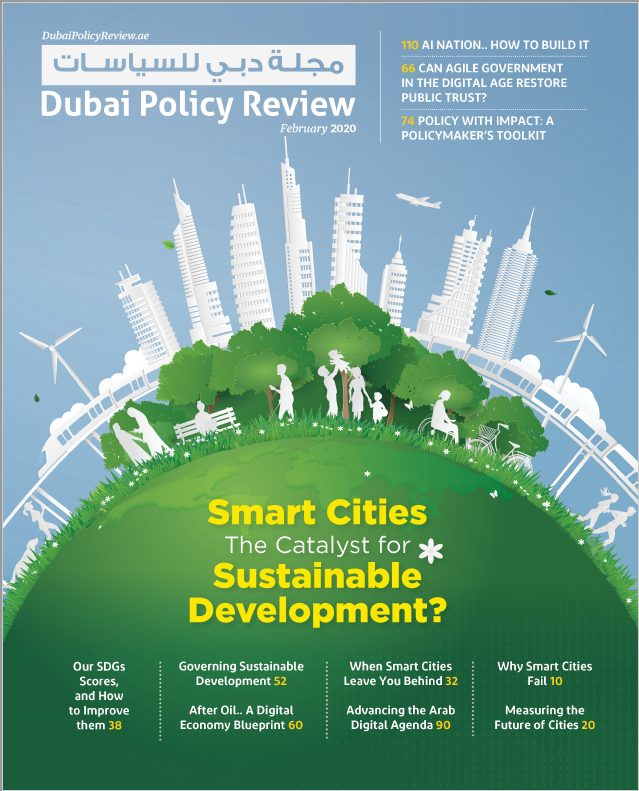Public managers seeking to create public value face a triple challenge: develop collaborative governance to find strategic approaches to wicked problems in an era of digital transformation. Collaborative governance enhances innovation by exploiting value that lies across organizational boundaries. Benefits of collaborative governance abound, but so do its challenges.
Wicked problems are defined as highly interdependent, multicausal, unstable and socially complex. To grasp how digital transformation fundamentally disrupts traditional management practices and how best to move forward, leaders should view it as a wicked problem. This article expands on these concepts and recommends how leaders and policymakers can effectively strengthen policy, design and outcomes and, in the process, create public value in the digital age.
Creating Public Value amid Digital Transformation
Digital transformation presents a dizzying array of challenges. Strategy demands clear, compelling direction and setting priorities to filter out the "nice to do" from "strategically important to do." Yet too many digital strategies pile up trendy projects to build and use exciting new tools, platforms and technologies but lack clear focus and hard thinking about the outcomes and longer term goals to be achieved. Digital transformation is a wicked problem because of the high levels of uncertainty, complexity, interdependence and adaptation it demands. Traditional public management strategies are inadequate to such a challenge. Public executives and leaders create public value1 when they effectively pursue an important, ambitious mission; mobilize and sustain external support for it from key stakeholders; and implement strong operations and management.
Wicked problems challenge leaders to engage multiple stakeholders at various levels with competing perspectives and to build management strategies to handle high uncertainty, ambiguity and dynamic developments. Contemporary governance requires visionary leaders and public executives who focus strategically on creating such value rather than simply enacting routine procedures and processes bureaucratically.
Contemporary challenges often lie inherently across jurisdictional, organizational, and geographic boundaries. Although many problems can be solved through linear, regularized processes within and across organizations, others will not respond to such approaches. National security challenges require expertise from a range of different stakeholders who may prefer not to communicate with one another. Youth services involve a range of expertise found in employment, education, health and other ministries. Climate change and environmental issues fall across different regions, jurisdictions, and levels of government.
Collaborative governance emphasizes the importance of cross-boundary management in a networked, highly interdependent world. Wicked problems demand more than simply an ability to work across boundaries but that skill forms an essential starting point. Cross-agency collaboration2 refers to the specifics – the "how" — of collaboration among government entities. Management and team skills to foster collaboration are important, but structural and institutional challenges, such as existing regulations and frameworks, must also be addressed. For example, do existing laws prohibit two entities from sharing information and processes? Do budget and accounting rules allow for cross-jurisdictional use of funds and building shared budgets? Do oversight bodies focus on the effectiveness of the partnership or only on single entities and programs? Traditional bureaucratic mindsets and rules impede cross-boundary partnerships.
The Tame and the Wild: Tackling Wicked Problems
Wicked problems are defined by high levels of interdependence, complexity, and ambiguity. The problem, its definition and description, and potential solutions are poorly understood and typically the focus of strong disagreement among experts from different fields or stakeholders with varying interests and perspectives. Steps toward solutions often produce unanticipated, negative consequences, or externalities, which themselves then change the definition of the problem. Horst W. J. Rittel and Melvin W. Webber first defined wicked problems in 1973 in the journal Policy Sciences as those for which there is no "clear path to an optimal solution, no consensus on what an optimal solution would look like, and not even a clear definition of the boundary of the problems to be confronted."3

Often such problems are simply avoided by public managers as too difficult to address, too complex to manage, and too interconnected to disentangle. At other times, linear systems approaches are applied to such problems without achieving much traction or exacerbating the problem. Policy and business analysts have found that wicked problems require a different management mindset and policy approach than more structured, linear challenges. Wicked problems present specific strategic management challenges4:
- Problems with multiple stakeholders who have different priorities and perceptions.
- Issues whose roots, or causes, are difficult to disentangle and to understand.
- Problems that change as decision makers apply various solutions and implementations of decisions. Policy analysts sometimes call these "squishy" problems.
- Challenges without precedent. While analogies to roughly similar problems may exist, the actual problem is unique.
- Difficulty assessing whether decision makers have made the right decisions to address the problem.
Wicked problems challenge leaders across the entire range of policy domains from the environment to security and intelligence. Climate change, terrorism, and digital transformation exemplify the complexity, extraordinary interdependence and uncertainties inherent in wicked problems. These complex challenges invite leaders to open up their thinking, to actively seek out multiple perspectives, to foster networks of experts to search for discrepant views, and to use multiple pilots and experiments to move forward with agility learning from failure as well as success.

How should leaders approach such problems?
- Involve stakeholders and develop communication patterns to engage different sources of expertise, including citizen and local perspectives, and remain open to multiple perspectives.
- Focus on overarching values, fundamental purpose, and a broad, guiding vision.
- Use incremental steps when possible to probe, test and learn. Select a small set of feasible actions. Experiment. Conduct pilots. Move forward on the basis of interim, partial results while refining an understanding of the problem. Find ways to allow for failure so that innovators can experiment using small-scale pilot projects, and be prepared to scale up if results warrant it.
- Be open to a range of scenarios and possibilities for the future, accepting and managing unpredictability by scanning and monitoring the environment in order to adapt quickly.
Much of the current emphasis on agility, design thinking, workshops and labs, and innovative processes is meant to shake up linear, structured thinking and to recognize the wicked nature of many contemporary challenges.
Ecosystem management experts advise "systemic approaches to wicc ked problems" to replace older equilibrium-based frameworks5. These include engaging multiple sectors in decision making, fostering institutional change to foster cross-boundary collaboration, expanding the notion of markets to include "natural capital", and specifically addressing inequalities that may result from ignoring key stakeholders. Underlying these approaches is the insight that cross-boundary problem-solving and local-level experimentation may yield the type of interim, first-hand knowledge essential to gaining traction on wicked problems. Top-down approaches may feel comfortable and allow executives to maintain an aura of control but are likely to make problems worse rather than better.
Consider the growing importance of smart cities – a small subset of digital transformation. Leaders should ask: In what ways are they "smart"? Are the forms of artificial intelligence in smart cities the types of intelligence needed to reduce poverty, increase employment, control pollution and invite entrepreneurship and creativity? What are the most important overarching goals of cities and how does digital transformation move cities along paths toward those goals? By opening up spaces for citizen engagement and local experimentation, policymakers can leverage small-scale learning to inform technological innovation.
Digital Transformation as a Wicked Problem
Leaders and managers should view digital transformation as a wicked problem. Digitalization poses challenges that cannot be met by gathering more data and information and using traditional problem solving and strategic planning methods. The disruptive nature of digital transformation has as much to do with people and their uses for technologies as the technologies themselves. The unanticipated nature of technological change is one reason it poses both opportunities and threats.
Countries, businesses and governments do not simply "transform" because of advances in digital technologies. The ways that people and organizations react to, use and "enact" new technologies shapes transformation6. Evidence is clear that increasing social and economic inequalities result from digital transformation if such inequalities are not proactively addressed by policy makers. New occupations, jobs and industries require new forms of education and training. Communication with multiple stakeholders each holding different perspectives is needed to chart a path forward. Technologists alone cannot solve the business, governance and social challenges of digitalization.
Consider the breadth of digital transformation. The digital age encompasses the past 25 to 50 years of diffusion of digital information and communication technologies into nearly every area of the economy, society and governance. Digital products, tools, services and platforms including personal computers, smartphones, broadband, the internet, the cloud, social media, artificial intelligence, robotics and the Internet of Things are advancing and being adopted at varying rates across industries, governments and society. Countries have barely begun to measure adoption and near-term impacts across the range of digital developments, but will need to do so to develop coherent strategies and plans.
Some experts refer to digitization as moving information and data from paper to digital form whereas digitalization typically refers to changing social interactions and business models to adjust to or exploit the value of digital technologies. Digital transformation refers to broader, deeper changes to industry and governance structures and ecosystems. Digitalization is highly uneven across industries, firms and other organizations, and occupations. Analysis of digitalization trends confirms that occupations at the high and low ends of the economic spectrum are growing, but that the middle continues to be hollowed out7. Training and education strategies can help ensure that the pipeline produces a labor force with the skills and expertise needed for digitalized organizations. Moreover, attention is focused increasingly on what it is that humans do that computers cannot do. Wicked problems by definition produce unanticipated consequences some of which lie outside the authorities and jurisdictions tasked with digital transformation. Thus, problems may fall through the cracks if multiple stakeholders are not part of transformation process planning.
Digitalization as a wicked problem calls for experimentation, pilot projects, rapid monitoring of interim results and feedback to refine problem definition. Yet even experimentation can become a trap: executive experience with digital transformation at the enterprise level suggests that experimentation is far less difficult than gathering results from such pilots to scale new practices and enable transformation8. Thus, to craft strategy and enterprise goals and paths forward, strategic use of digital technologies requires active executive judgment, not simply technologist driven initiatives.
While digitalization clearly achieves faster, better, cheaper results in the short run, managing transformation to create greater public value entails deeper rethinking and adjustment of governance, business models, partnerships, and institutional arrangements. Large organizations often adopt hundreds of new technologies and applications at the same time. Disentangling these investments and their results can be daunting but often reveals a proliferation of interesting experiments with too little thought given to strategic change and dissemination of the most promising initiatives. This last step requires the hard work of managing change in and across organizations requiring what are sometimes painful disruptions to power, authority, resources and traditions. Because enterprise-level change is costly, enterprises must start with a broad strategy encoding values and ideals toward which they can progress flexibly as the gains from short-term initiatives are combined with longer-term, deeper transformation that itself evolves through learning and evolution.
Re-thinking Digital Transformation in the Arab Region
This brief article invites leaders to think of digital transformation through the lens of wicked problems and their characteristics. Digital transformation poses an extraordinary case of a wicked problem, one that cannot be avoided and that holds great promise as well as threats. Recently, leaders in the Arab region have embarked on a strategy to advance the digital economy across the Arab League states. Many countries within the League already have developed digital government and economic strategies. This article invites leaders to examine the potential for greater engagement among multiple stakeholders, broad communication and problem solving, agile experimentation and flexibility in devising paths forward — all in the context of an overarching vision that encodes values and fundamental goals to build the future of government.
Jane E. Fountain is Distinguished University Professor of Political Science and Public Policy at UMass Amherst and founder and Director of the National Center for Digital Government. Read full bio here.
End Notes:
1. https://www.weforum.org/whitepapers/government-government-with-the-people-a-new-formula-for-creating-public-value
2. http://www.businessofgovernment.org/report/implementing-cross-agency-collaboration-guide-federal-managers
3. http://www.sympoetic.net/Managing_Complexity/complexity_files/1973%20Rittel%20and%20Webber%20Wicked%20Problems.pdf
4. https://hbr.org/2008/05/strategy-as-a-wicked-problem
5. https://www.researchgate.net/publication/316286606_Ecosystem_management_as_a_wicked_problem
6. https://www.brookings.edu/book/building-the-virtual-state/
7. https://www.brookings.edu/research/digitalization-and-the-american-workforce/
8. https://www.weforum.org/reports/the-digital-enterpise-moving-from-experimentation-to-transformation












You must be logged in to post a comment.